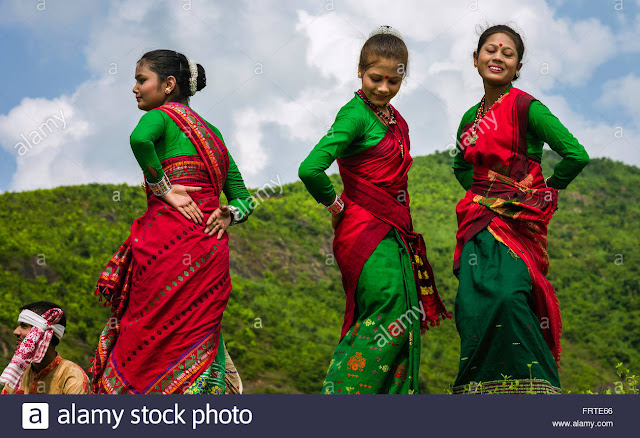Festivals bring respite into our busy and daily
hustle bustle of life.Festivals revitalize
a new light and hopes in us. Bihu is set of festivals, the most important festival of Assam. Bihu is three different cultural festivals that are
celebrated in different times of the year.People of Assam commemorating the
change of season in accord with the Assamese calendar. Assam, one of the
most beautiful states of India, known for its tea gardens, lush green forests
and the mighty Brahmaputra River. The warmth and friendliness of
Bihu is what makes it one of the most loved and enjoyed festivals in India.
The origin of the word ‘Bihu” is said to be from the Sanskrit word ‘Vishu’. However, according to some, “Bi” means “to ask” and “Hu” means “to give”.
as Rongali Bihu.
is the first Bihu, which marks the beginning of Assamese new year in April and is
celebrated with grandeur to welcome the spring.This festival coincides with
other Indian Festivals, namely, Baisakhi, Sankranti and Chait.
 |
| Bihu Dance |
with happiness and merriment. Laddos and varieties of Pithas are made on
this occasion and Jolapn is the main delicacy which people eat on this
festival.
Bihu” and on this day, the cattle are taken to the river or pond to clean
them and offer prayer. This day is celebrated on the last day of the month.
 |
| Bihu Dance |
wear new clothes and celebrate this festival with vigor and enthusiasm. During Bohag Bihu, Bihu
Dance, the famous folk dance of Assam is performed on Bihu geet.
Bihu or Kati Bihu .
celebrated in mid-October, when the crops are growing but the farmers’
granaries are depleting.
maturing paddy, cultivators whirl a piece of bamboo and recite rowa-khowa chants and spells to
ward off pests and the evil eye. During the evening, cattle are fed specially
made rice items called pitha.
harvest. On this day, tulsi plant is planted on the fields to seek
blessings for prosperity and protecting the paddy from being affected.On this day lamps, called saki, are lit on the tips of bamboo
poles in the fields, as a guide to spirits.
granaries.Farmers also chant spells to ward off negativity and pests, praying
for successful harvests. Cattle are fed especially prepared items known
as pitha, made of
rice.
harvest. On this day, tulsi plant is planted on the fields to seek
blessings for prosperity and protecting the paddy from being affected.
Bihu also known as Bhogali Bihu
a harvesting festival celebrated in the month of Magh of the Hindu calendar and
mid-January of the Georgian calendar.It is the period when the hard
working agricultural folk of Assam sit down to reap the benefits of their labor. Everyone
celebrates the festival with great fervor, right from the smallest of villages
to the big towns and cities of Assam.
because the granaries of people are filled with grains. This is basically
the season of eating and merrymaking.
the eve of this festival, which is called “Uruka” is celebrated with grandeur
and people get together for feasting. People construct Meji and Bhelaghar, a
makeshift cottage, inside which people feast.
morning, people offer prayers to the Fire God and several sports are organized
like cock-fight, buffalo-fight, Nightingale-fight and Egg-fight for the
entertainment of people.
characterized by brisk dance steps, rapid hand movement, and a rhythmic swaying
of the hips in order to represent youthful passion. Dancers wear traditionally
colorful Assamese clothing.
performed in conjunction with traditional Bihu folk music, played with: the
“dhol”, similar to a drum; the mohor singor pepa, a pipe instrument
made from a buffalo horn; the tala, a cymbal; the gogona, a reed and bamboo
instrument; and the toka, a bamboo clapper.
accompany the dance have been handed down for many generations. The subject of
the lyrics ranges from welcoming the Assamese new year to describing the daily
life of a farmer.
of the dance remains the same: to express the desire to feel both pain and
happiness.
case with Bihu. There are many instruments that are utilized during a Bihu
performance namely a dhol, pepa, Taal, toka, xutuli, gogona and baanhi. Not
even one musical instrument can be ruled out of the list as they all play a
pivotal role in producing the traditional tunes for the Bihu performance. A
traditional Bihu performance is eye catching and worth cherishing as it recites
the happiness and heritage of the Assamese people.
energetic dance steps and quick hand movements define the Bihu dance of Assam.
But that is not all as any folk dance is incomplete without its costume and
jewelry and the performers of Bihu don the traditional Assamese attire. This dance is performed usually by the young males and females
to show their joy and merriment on the arrival of spring season. A lot of vibrancy
can be seen in the dance outfit of Bihu and that is what depicts the genuine
spirit of this dance form.
vital part of every folk dance and the same is the case with Bihu. There are
many instruments that are utilized during a Bihu performance namely a dhol,
pepa, Taal, toka, xutuli, gogona and baanhi. Not even one musical instrument can be ruled out of the list as
they all play a pivotal role in producing the traditional tunes for the Bihu
performance. A traditional Bihu performance is eye catching and worth
cherishing as it recites the happiness and heritage of the Assamese people.
photos available on net and with thanks to photographer of these photos.
. I
am sure after reading this write up, you will fall in love with Assam and
people of Assam.













